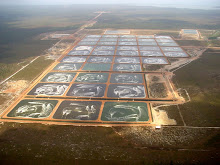 Vinyl progress: not as much growth as the screens, but stays lightweight and the smooth surface makes it easy to remove material.
Vinyl progress: not as much growth as the screens, but stays lightweight and the smooth surface makes it easy to remove material.
Fiberglass screen is a close second to the steel in amount of growth.
 Rubber comes dead last in terms of growth. Material (dirt?) comes off just by touching. But its close neighbor, the steel screen, wins the prize.
Rubber comes dead last in terms of growth. Material (dirt?) comes off just by touching. But its close neighbor, the steel screen, wins the prize.Note the abscence of the weed mat. It was growing little more than the rubber, and then was removed from the PVC by the lake. I didn't rescue it.
Lessons learned from this experiment so far:
-This rubber will not work.
-A fiberglass or steel screen may encourage more growth, but they complicate removal quite a bit, since the material can't just 'slide' off.
-Vinyl is most compatible with our current removal plan (see below) but it hasn't accumulated a whole lot of biomass.
In the near future I plan to take sample material under a microscope to see what exactly we "caught".
Another order of business:
The biomass-removal group met to explore our ideas.
We briefly researched algae removal techniques and found little of use. The nets came up with a variety of lake and aquarium algae removal devices, ranging from vacuums to string algae brushes. The closest device we found to our dreamed-up device was a flexible stainless steel scraper shaped like a rake, designed for scraping algae from large glass aquarium sides.
In our meeting, EFritzch proposed his idea for the device and we critiqued/improved it. I'll have him post about this, but it basically allows for one-sweep scraping without repeatedly having to pull the scraper in and out of the boat.
And lastly, welcome IHS students! We're so glad to be able to collaborate with you on this project.




My idea for a biomass-removal device is pretty simple but would have to be built, but it would be relatively cheap to build. Basically, it would look like a large pair of hedge clippers but a long, thin, blunt material (possible plastic or hard rubber) would replace blades. This is so you can have biomass from both sides of the substrate be collected at one time. It would also be designed so that when it clamps together the plastic "blades" are parallel to each other with no overlap.
ReplyDeleteExcellent!
ReplyDeleteSo we're leaning toward a sheeting material as the substrate with a blunt scraper.